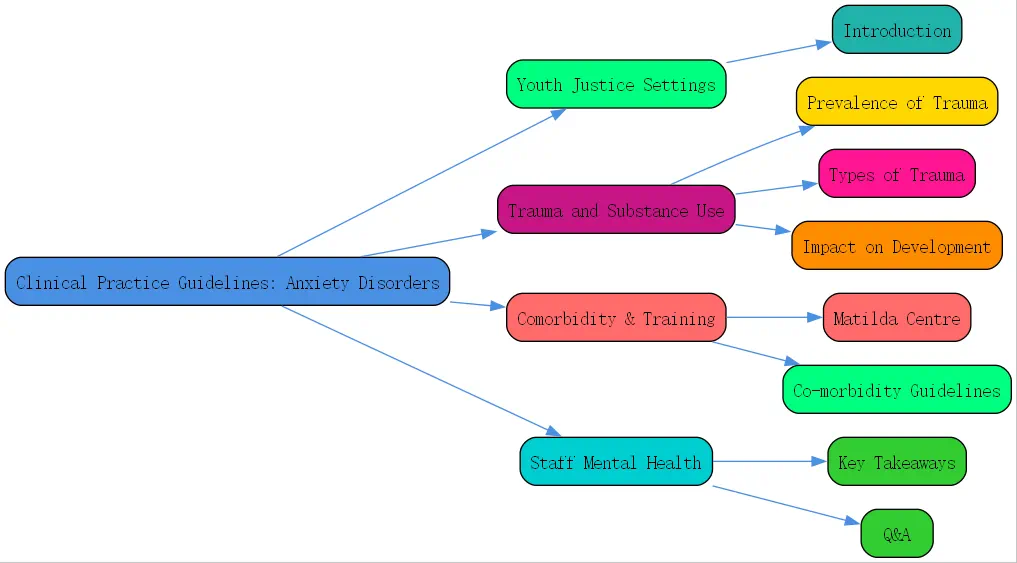Clinical Practice Guidelines for Management of Anxiety Disorders in Youth Justice Settings

Navigating the complexities of mental health within youth justice settings presents unique challenges. Young people involved with the justice system often face a confluence of factors, including trauma, substance use, and significant mental health difficulties like anxiety disorders. Addressing these issues effectively requires a coordinated, evidence-based approach, grounded in solid research and collaboration.
Introduction to Mental Health and Substance Use in Youth Justice
Recognizing the critical need for enhanced support, initiatives like the collaboration between the University of Sydney and Youth Justice NSW are paving the way. Signed in mid-2024, this partnership aims to foster greater synergy, leveraging academic expertise to address pressing issues within the youth justice environment. Showcasing the work of specialized groups like the Matilda Centre highlights the cutting-edge research being applied to real-world problems.
The intersection of mental health conditions and substance use, known as comorbidity, is particularly prevalent among young people in custody. Effectively managing these co-occurring issues is paramount, not only for the well-being of the young individuals but also for potentially reducing recidivism. Understanding the underlying factors, such as trauma, is crucial for developing targeted interventions.
This article delves into key areas informed by recent research presentations. We will explore the profound impact of trauma and substance use among young people in custody, examine the development of comorbidity guidelines and workforce training needs, and underscore the vital importance of supporting the mental health of staff working within these challenging settings. We will focus on the clinical practice guidelines management of anxiety disorders and related strategies.
Trauma and Substance Use Among Young People in Custody
Trauma exposure is unfortunately common, but its prevalence and impact are significantly heightened among young people within the justice system. Understanding the scale and nature of this trauma is the first step toward providing appropriate care and developing effective management strategies, including those for related anxiety disorders.
Prevalence of Trauma Among Young People
Research paints a stark picture of trauma exposure even in the general population. Australian studies indicate that a significant portion, around 41% of adults, experienced trauma before age 17. Common experiences include witnessing domestic violence, the unexpected death of a loved one, or experiencing sexual and physical assault. Multiple trauma exposures are also frequent.

When focusing specifically on young people, studies involving large samples reveal high self-reported trauma rates. Half of 18-year-olds reported experiences like assault, accidents, or disasters, while a third of 13-year-olds reported adverse childhood events like abuse or neglect. These baseline figures underscore a societal issue with profound implications.
The situation becomes even more acute within incarcerated populations. Surveys within Youth Justice NSW reveal alarmingly high rates: close to half of young people in custody have experienced trauma, and a staggering 68% report childhood abuse or neglect. These figures dramatically exceed those seen in the general youth population, highlighting a critical vulnerability.
Types of Trauma Experienced by Young People in Custody
The types of trauma experienced by youth in custody are varied and severe. Data indicates that witnessing someone being badly injured or killed is among the most common experiences. This is often followed by direct physical assault, involvement in life-threatening accidents, and other significant traumatic events. Understanding these specific experiences helps tailor support.
These traumatic events often occur repeatedly, creating layers of psychological distress. The cumulative effect of multiple traumas significantly increases the risk for developing severe mental health conditions, including complex anxiety disorders and PTSD, complicating their journey through the justice system and beyond.
Recognizing the specific traumas prevalent in this population is essential for informing screening processes and therapeutic interventions. A trauma-informed approach acknowledges these experiences and integrates this understanding into all aspects of care and management within the youth justice setting. Effective `anxiety stress management techniques` often need to be trauma-specific.
Impact of Trauma on Young People’s Development
Childhood and adolescence are periods of intense neurobiological and psychosocial development. Trauma exposure during these critical windows can disrupt normal developmental trajectories, leaving lasting impacts. The brain is particularly malleable, making it highly susceptible to the effects of overwhelming stress and fear associated with traumatic events.
Trauma can fundamentally alter a young person’s developing sense of self, their ability to form healthy relationships, and their perception of the world as a safe place. It can interfere with the development of self-awareness, emotional regulation, and a sense of independence, critical milestones during adolescence that shape adult functioning.
The consequences ripple outwards, increasing the risk for a cascade of difficulties. These include lower educational attainment, unemployment, homelessness, engagement in high-risk behaviors, aggression, and unfortunately, further involvement with the justice system. Chronic physical health conditions and severe mental health disorders, including anxiety and substance use disorders, are also strongly linked. The earlier and more frequent the trauma, the greater the risk.
Post-Traumatic Stress Disorder (PTSD) in Youth Justice Settings
Post-Traumatic Stress Disorder (PTSD) is a specific and debilitating anxiety disorder that can develop following exposure to a traumatic event. Its diagnosis, according to frameworks like the DSM-5, involves distinct clusters of symptoms that cause significant distress or impairment in functioning. Understanding these is key to recognition and treatment.

The core symptom clusters include re-experiencing symptoms (like intrusive memories, nightmares, flashbacks), avoidance symptoms (actively avoiding trauma-related thoughts, feelings, people, or places), negative alterations in cognition and mood (negative beliefs, distorted blame, persistent negative emotions, detachment), and marked alterations in arousal and reactivity (irritability, angry outbursts, hypervigilance, concentration problems, exaggerated startle response).
Research highlights a dramatically higher prevalence of PTSD in correctional settings compared to the general population. Studies among adult prisoners found PTSD rates to be potentially 10 times higher. Within youth justice, surveys indicate around 13.5% meet full criteria for PTSD, significantly above community rates. These figures underscore the urgent need for targeted mental health services.
Furthermore, many young people in custody experience significant sub-syndrome PTSD symptoms. While they may not meet the full diagnostic threshold, they suffer from distressing re-experiencing, avoidance, or arousal symptoms that still impair their functioning and well-being. Interestingly, symptom prevalence didn’t significantly differ by gender or Aboriginality in some studies, indicating a widespread issue across the population. Addressing these symptoms requires robust `anxiety stress management techniques`.
Comorbidity Guidelines and Workforce Training for Anxiety Medication Management
Addressing the complex needs of young people experiencing trauma, anxiety, and often substance use requires specialized approaches. Organizations like the Matilda Centre are at forefront, developing innovative solutions and contributing to the evidence base needed for effective interventions and robust `clinical practice guidelines management of anxiety disorders`.
The Matilda Centre’s Innovative Solutions
The Matilda Centre at the University of Sydney focuses on providing cutting-edge solutions for mental health and substance use disorders, recognized as leading causes of burden among young people globally. Their mission involves bringing together top researchers dedicated to prevention, early intervention, and treatment of these often-intertwined conditions.
Their research aims to build a strong evidence base that supports a thriving and empowered younger generation. A key aspect of their approach involves actively engaging with policymakers, service providers, and individuals with lived experience. This collaborative model ensures that research translates into practical, impactful changes in real-world settings like youth justice.
The relevance of their work to Youth Justice NSW is clear. Given that young people in custody are six times more likely to have a mental health or substance use disorder, the Matilda Centre’s expertise is invaluable. Their research directly informs strategies to address the links between mental health, substance use, and offending behavior.
Co-morbidity Guidelines and Workforce Training
A critical area of focus is the development and dissemination of guidelines for managing comorbidity 閳?the co-occurrence of mental health and substance use disorders. Effective management requires integrated approaches that address both issues simultaneously, rather than treating them in isolation. This necessitates clear protocols and skilled staff.
Existing resources are being developed and refined to upskill youth justice staff. Training programs aim to equip personnel with the knowledge and skills needed to recognize signs of mental distress and substance use, respond appropriately, and support young people effectively. This includes understanding trauma-informed care principles and basic `anxiety stress management techniques`.
While therapeutic interventions are crucial, comprehensive management may also involve careful consideration of `anxiety medication management`. This typically requires specialist psychiatric assessment and ongoing monitoring, integrated within a broader care plan that includes psychosocial support. Guidelines should address when and how medication might be considered as part of a holistic strategy. Having accessible resources, perhaps compiled in a `management of anxiety disorders pdf`, can support consistent practice.
Anxiety Stress Management Techniques and Support for Staff Mental Health
While the focus is often rightly on the young people within the justice system, the well-being of the staff who support them is equally crucial. Working in these demanding environments takes a significant toll, and providing adequate support for staff mental health is essential for maintaining a therapeutic and safe environment.
Supporting staff mental health is not just beneficial for the individuals; it’s critical for the effective functioning of the youth justice system. Staff who feel supported and equipped are better able to manage stress, build positive relationships with young people, and implement therapeutic programs consistently. Burnout and secondary trauma are significant risks in this field.
The challenges inherent in working within a custodial environment are immense. Concerns about safety, managing complex behaviors, and witnessing the effects of trauma can be overwhelming. Recent global events, like the COVID-19 pandemic, added further layers of stress and complexity, impacting both young people and staff within these confined settings during 2025 and prior years.
Therefore, providing resources and dedicated support for staff mental health is non-negotiable. This includes access to confidential counseling, peer support programs, and training in `anxiety stress management techniques` tailored to their work context. Creating a culture that prioritizes staff well-being is fundamental to ensuring sustainable and effective care for the youth they serve. BrainTalking recognizes the importance of resources for both clients and practitioners.
Key Takeaways: Managing Anxiety in Youth Justice
- High Prevalence: Trauma, PTSD, anxiety disorders, and substance use are significantly more common among youth in custody than in the general population.
- Trauma’s Impact: Early and repeated trauma profoundly affects development, increasing risks for mental health issues, offending, and other life difficulties.
- Comorbidity is Key: Mental health and substance use issues often co-occur and require integrated treatment approaches.
- Need for Guidelines: Clear clinical practice guidelines management of anxiety disorders tailored to the youth justice population are essential for consistent, evidence-based care.
- Comprehensive Care: Management may involve therapy, trauma-informed practices, `anxiety stress management techniques`, and potentially `anxiety medication management` under specialist guidance.
- Staff Support: Supporting the mental health and well-being of youth justice staff is crucial for effective service delivery and preventing burnout. Access to resources like a `management of anxiety disorders pdf` summary could also benefit staff.
- Collaboration: Partnerships between research institutions (like the Matilda Centre) and justice systems are vital for translating evidence into practice.
Q&A: Accessing Anxiety Management Resources
Question: Where can youth justice professionals find reliable resources like a `management of anxiety disorders pdf` or information on current best practices?
Answer: Finding reliable, evidence-based resources is crucial for effective practice. Professionals should look towards several key sources:
1. Government Health Departments: National and state/provincial health departments often publish clinical guidelines and resources for mental health conditions, sometimes with sections relevant to specific populations or settings. 2. Professional Psychological/Psychiatric Associations: Organizations like the American Psychiatric Association (APA) or the Australian Psychological Society (APS) often develop and disseminate practice guidelines based on the latest research. They may offer summaries or full guidelines, sometimes in accessible formats like PDFs. 3. Specialized Research Centers: Institutions like the Matilda Centre, focused on youth mental health and substance use, are excellent sources for cutting-edge research findings, reports, and potentially training materials or intervention protocols. Check their websites or contact them directly. 4. Academic Databases: Searching databases like PubMed, PsycINFO, or Google Scholar using specific keywords (e.g., “”anxiety treatment guidelines youth justice,”” “”comorbidity mental health substance use adolescent””) can yield relevant research articles and reviews, though access may require institutional affiliation. 5. Reputable Mental Health Organizations: Non-profits and advocacy groups focused on mental health (e.g., NIMH in the US, Beyond Blue in Australia) often provide summaries of conditions and treatments, sometimes linking to more detailed professional resources. BrainTalking aims to provide accessible summaries of complex topics as well.




